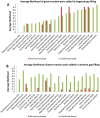Likelihood-based gene annotations for gap filling and quality assessment in genome-scale metabolic models
- PMID: 25329157
- PMCID: PMC4199484
- DOI: 10.1371/journal.pcbi.1003882
Likelihood-based gene annotations for gap filling and quality assessment in genome-scale metabolic models
Abstract
Genome-scale metabolic models provide a powerful means to harness information from genomes to deepen biological insights. With exponentially increasing sequencing capacity, there is an enormous need for automated reconstruction techniques that can provide more accurate models in a short time frame. Current methods for automated metabolic network reconstruction rely on gene and reaction annotations to build draft metabolic networks and algorithms to fill gaps in these networks. However, automated reconstruction is hampered by database inconsistencies, incorrect annotations, and gap filling largely without considering genomic information. Here we develop an approach for applying genomic information to predict alternative functions for genes and estimate their likelihoods from sequence homology. We show that computed likelihood values were significantly higher for annotations found in manually curated metabolic networks than those that were not. We then apply these alternative functional predictions to estimate reaction likelihoods, which are used in a new gap filling approach called likelihood-based gap filling to predict more genomically consistent solutions. To validate the likelihood-based gap filling approach, we applied it to models where essential pathways were removed, finding that likelihood-based gap filling identified more biologically relevant solutions than parsimony-based gap filling approaches. We also demonstrate that models gap filled using likelihood-based gap filling provide greater coverage and genomic consistency with metabolic gene functions compared to parsimony-based approaches. Interestingly, despite these findings, we found that likelihoods did not significantly affect consistency of gap filled models with Biolog and knockout lethality data. This indicates that the phenotype data alone cannot necessarily be used to discriminate between alternative solutions for gap filling and therefore, that the use of other information is necessary to obtain a more accurate network. All described workflows are implemented as part of the DOE Systems Biology Knowledgebase (KBase) and are publicly available via API or command-line web interface.
Conflict of interest statement
The authors have declared that no competing interests exist.
Figures






References
Publication types
MeSH terms
Grants and funding
LinkOut - more resources
Full Text Sources
Other Literature Sources
Miscellaneous

